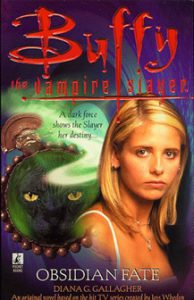After the excellent Golden/Holder “Gatekeeper Trilogy,” I braced myself for a letdown with Diana G. Gallagher’s first entry in the “Buffy” series, “Obsidian Fate” (September 1999). While it is indeed a step down, it’s quite readable, with the new character Dem Inglese providing a perspective not explored in the TV show.
The nerdy new Sunnydale High student is rebuffed in his attempts to befriend Buffy, on whom he has a crush. We know why she’s reluctant to expand the group of people who know about the supernatural world, but of course Dem does not. When he overhears a Scooby Gang meeting in the library, he assumes Giles is insane and he has manipulated Buffy and friends (who, at first glance, don’t have anything in common) into his cult – a logical conclusion for an outsider.
The TV show didn’t go this in-depth with the concept of the outsider perspective, although it touched on it via Jonathan, who at one point seeks to check out a book, leaving the Scoobies baffled as to why someone else is in “their” library. And in Season 1’s “Never Kill a Boy on a First Date,” Owen awkwardly tags along on a Slayer mission; he gets knocked out at a time that’s convenient for the plot. The same thing happens to Dem early in “Obsidian Fate,” but eventually he learns all about the supernatural world. Indeed – frustrated by being shut out by the Slayerettes – he is manipulated by an Aztec jaguar god into becoming its ixiptla, a human who lives in luxury before being sacrificed (“Kolchak: The Night Stalker” also explored this idea in the episode “Legacy of Terror”).
I assumed Dem would get killed off or get his memory erased, but he survives and returns to Sunnydale High School. As this book is set in the second half of Season 3, I like to think Dem is one of the students — along with Jonathan, after the events of “Earshot” (18) — who pushes for Buffy to get the Class Protector award in “The Prom” (20).
Unlike previous books in the “Buffy” series, “Obsidian Fate” fits nicely on the timeline. Since everyone is talking about their college entrance exams, it takes place after “Lovers Walk” (8), and because Oz and Willow are back together, it takes place after “Amends” (10). It takes place before “Bad Girls” (15) and “Consequences” (16), since Mr. Trick is still the minion of Mayor Wilkins, Faith isn’t yet evil and Wesley is not mentioned. (At one point, reference is made to a past event happening in late 1999, instead of late 1998, but we can write that off as a typo.)
Although she doesn’t appear in this book, Faith is mentioned for the first time in the adult novels on page 32:
Unlike Kendra and Faith, who had both lived to slay – Kendra from a profound sense of duty and Faith because she liked offing vamps – Buffy refused to totally relinquish her life as an ordinary, confused and tortured teenager.

Although the history-oriented plot – heavy on an ancient Aztec evil – smacks of Season 1 (particularly “I Robot, You Jane”), Gallagher hits on the major Season 3 themes. Among these are Buffy and Angel struggling with their feelings, and Giles dealing with Jenny’s death – indeed, a potential new love interest, Lucy, looks like his former lover. The author veers toward overwriting these familiar character arc points, but I found it enjoyable to revisit this era.
The wrong date that I mentioned above is just the tip of the iceberg of typos in “Obsidian Fate.” Wilkins is misspelled “Wilkens,” Angelus is misspelled “Angeles” and there are several other small errors. The book clearly needed one more pass from a copy editor.
The threat of the jaguar god isn’t particularly compelling. It’s established that our heroes must smash the obsidian mirror once the jaguar god returns to it, as he must do during daylight hours. In the final act, some of our heroes actually sleep in their cage, waiting for the ritual sacrifice – and their chance to break out – just before sunrise. The idea of the sun blotting out Sunnydale presages the sun blocking out Los Angeles in Season 4 of “Angel.” In both cases, it’s hard to figure out how that works, but I guess we can write it off as “magick.”
Juan, the featured artist at Joyce’s gallery, somewhat calls to mind Ampata (the boy who is killed off in the teaser, not the girl who takes his name) from Season 2’s “Inca Mummy Girl,” although Gallagher doesn’t do much with him. “Obsidian Fate’s” roster is overfilled, as there’s also a whole History Club of potential minions/sacrifices. Perhaps I should give the author credit for trying to infuse some personality into the pawns, but the large cast leads to the heroes being somewhat shortchanged. Indeed, Buffy’s worries about Angel being dead in the closing chapters are too rote. “Obsidian Fate” is rough around the edges, but it retains some appeal because of Dem’s refreshing outsider perspective on a “Buffy” adventure.
Click here for an index of all of John’s “Buffy” and “Angel” reviews.

